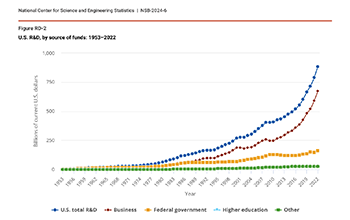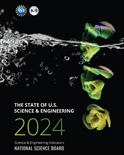
New report shows that business R&D funding dominates the U.S. R&D enterprise

U.S. R&D, by source of funds: 1953-2022 (Credit and Larger Version)
May 21, 2024
The United States is the largest performer of research and experimental development (R&D), with $806 billion in gross domestic expenditures on R&D in 2021, followed by China, with $668 billion. While overall funding of R&D in the U.S. continues to rise rapidly, the share of basic research funded by the federal government has fallen in the previous decade. Business funding of U.S. R&D surpassed federal funding in the 1980s and now dominates the U.S. R&D enterprise. These are among the findings in Research and Development: U.S. Trends and International Comparisons published today by the National Science Board (NSB).
Prepared by the National Center for Science and Engineering Statistics under NSB guidance, this report is part of the 2024 edition of the congressionally mandated Science and Engineering Indicators report on the state of the U.S. science and engineering enterprise.
The business sector is by far the largest performer of U.S. R&D, performing an estimated $693 billion in 2022, or 78% of U.S. R&D. Nearly 80% of business investment is in experimental development – the stage when the promise of near-term commercial benefit is real. Private sector R&D is also highly concentrated, clustering in a few key sectors such as information technology and pharmaceuticals.
Industry is well positioned to advance knowledge in targeted fields,” says Roger Beachy, NSB member and Washington University Professor Emeritus. “But only the federal government has invested across all fields, across the nation, at scale, and over long-time horizons to create new knowledge that helps us address current and future security, health, and economic challenges.”
Additional takeaways:
- Other top R&D performers are Japan ($177 billion), Germany ($154 billion), and South Korea ($120 billion).
- The United States is among the world’s most R&D-intensive economies, with R&D expenditures equaling 3.5% of its gross domestic product in 2021. Israel and South Korea had R&D intensities above 4%. Taiwan, Japan, and Germany were between 3% and 4%, and the United Kingdom and China above 2%.
- In the U.S., higher education performed the second most R&D in 2022, after business.
- Funding for life sciences research was the highest among S&E fields across agencies at $42 billion (44% of the total), primarily from the Department of Health and Human Services.
Research and Development: U.S. Trends and International Comparisons is the ninth of 10 Science and Engineering Indicators reports published. In the coming weeks, NSB will publish the final 2024 Indicators report, The STEM Labor Force: Scientists, Engineers, and Skilled Technical Workers.
About Science and Engineering Indicators
Science and Engineering Indicators is a congressionally mandated report on the state of the U.S. and international science and engineering enterprise. Indicators provides high-quality quantitative information on the enterprise in a series of reports and a data tool that provides state-level data.
About the NSB
The National Science Foundation Act of 1950 charged the NSB with two roles: to be the governing board of the NSF and an advisor to Congress and the President on policy matters related to STEM research and STEM education. Selected for their distinguished service and accomplishments in academia, government, and the private sector, the Board’s 24 presidentially appointed members are leaders in STEM research and education.
About the NCSES
NSF’s National Center for Science and Engineering Statistics (NCSES) is the nation's leading provider of statistical data on the U.S. science and engineering enterprise. As a principal federal statistical agency, NCSES serves as a clearinghouse for the collection, interpretation, analysis, and dissemination of objective science and engineering data.
Media Contact: Nadine Lymn, National Science Board, (703) 292-2490, nlymn@nsf.gov
Useful NSB Web Sites:
Home Page: http://www.nsf.gov/nsb
Media Contact: http://www.nsf.gov/staff/staff_bio.jsp?lan=nlymn&org=NSF
News: http://www.nsf.gov/nsb/news
Meetings: http://www.nsf.gov/nsb/meetings
Publications: http://www.nsf.gov/nsb/publications
Facebook: https://www.facebook.com/NationalScienceBoard
Twitter: Twitter: https://twitter.com/intent/user?screen_name=NSF_NSB
YouTube: https://www.youtube.com/channel/UCkrHRzuGSrPp2haQs0T_Pww
To view PDF documents, please download Adobe Acrobat Reader.




